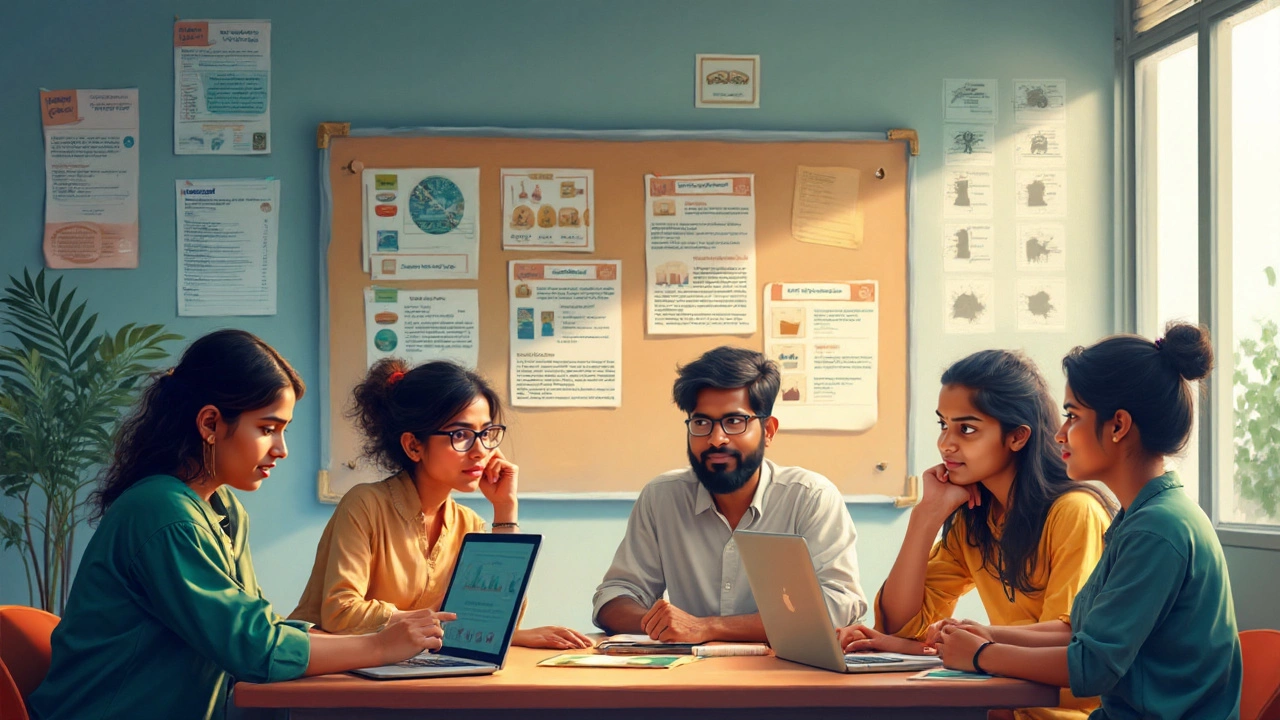Best Charities for Poverty Relief: Who Actually Helps the Poor the Most?
 Aug, 5 2025
Aug, 5 2025
Did you know that giving money to a random charity doesn't always guarantee it will reach people who need it the most? Some organizations use up half your donation just keeping their lights on or paying salaries. Others turn small donations into miracles—food, shelter, jobs, and hope for people who’ve got nothing left. If you’ve ever felt lost trying to figure out which charities actually make a big difference for the poor, you’re definitely not alone. Let’s dig in and sort this out.
How Top Poverty Charities Really Operate
You might picture a food bank handing out parcels, or an overseas group helping kids go to school. But behind the scenes, the way charities work can be wildly different. Some focus on emergency aid—think disasters, war, or sudden hunger. Others zero in on long-term fixes like education, healthcare, or helping people start small businesses. The big question: which approach actually leads to real, lasting change for those living in poverty?
One big player is Oxfam, known worldwide and active in over 80 countries. Oxfam gets a lot of attention for tackling root problems—like fighting for women’s rights, building schools, or teaching new ways to farm during drought. In 2024, their numbers were pretty strong: about 79% of donations went directly to projects on the ground. They also push hard for policy changes, which can be slow but make a long-term dent in poverty. But Oxfam isn’t perfect. Sometimes, critics say it’s too much about advocacy and not enough about direct help.
Then there’s GiveDirectly, a newer charity that almost flips charity tradition on its head. Their idea? Just give cash straight to people in need—no strings, and local families choose what they spend it on. Studies from MIT and Innovations for Poverty Action have found this works shockingly well. Not only does it help with basics (food, rent, school fees), but it also lets people invest in businesses, pay medical bills, or fix their homes. GiveDirectly’s admin costs in 2024 averaged about 11%, meaning roughly 89% of your donation gets to the poor directly. That's one of the best ratios out there.
One more example that people often overlook is local charities. These smaller, community-run groups like The Smith Family (Australia’s education charity) and St Vincent de Paul Society are everywhere here in Brisbane. Smith Family spends over 70% of their budget directly supporting kids in low-income families. They offer regular help with school costs, tutoring, and mentoring—making a steady difference in breaking the cycle of poverty.
All these charities show there isn’t one perfect method. Emergency aid saves lives in a crisis. But without solving bigger problems—like education gaps or poor health—people tend to stay stuck in poverty. The standouts combine quick fixes for today with clever ideas for tomorrow, all without burning a pile of cash on admin or advertising.
| Charity Name | Focus Area | % Funds To Programs (2024) | Known Impact |
|---|---|---|---|
| Oxfam | Global development, advocacy | 79% | Policy change, education, gender equality |
| GiveDirectly | Direct cash transfers | 89% | Immediate poverty reduction, business growth |
| Smith Family | Australian children’s education | 71% | School retention, higher achievement |
| St Vincent de Paul | Emergency relief, housing, welfare | 82% | Shelter, bill help, long-term support |
| CARE International | Women, disaster aid | 91% | Maternal health, community gardens |
One thing the best groups have in common: transparency. Good charities publish their financials. You can see where your money goes, how much is spent helping people, and what impact they’re having. If a charity doesn’t show this stuff, that's a red flag. Another tip is to check sites like GiveWell or The Life You Can Save—they use hard data to rank top performers. These sites usually put GiveDirectly, Oxfam, and Against Malaria Foundation near the top, but local charities sometimes outshine the big names in pure results per dollar (especially for food and emergency aid).
Don’t forget—every charity has critics. Sometimes big names slip up. In 2022, Oxfam got scrutinized for how it handled staff misconduct. Even local food banks sometimes face questions over expenses and fairness. No group is flawless, but the great ones learn from mistakes and bounce back stronger. Reading annual reports and reviews from actual families or recipients can be a surprisingly good way to check how a charity’s actually performing, not just what it claims in marketing.

Key Factors That Make a Charity Stand Out
So what actually sets apart the most effective charities for the poor? It’s not just about who’s got the flashiest campaign or the slickest website. Here are the things experts and regular donors should watch for:
- Impact per dollar: Can the charity show real, measurable changes with each dollar you give? Independent audits and third-party studies are gold here.
- Transparency: Are finances visible? Can you see exactly where your money goes? The best charities brag about how little they spend on admin and fundraising.
- Community involvement: Locals often know what works best. Charities that listen and include the poor in their own plans typically get better, longer-lasting results.
- Scalability: Can this charity’s success be repeated, or does it only work in a particular place or with a certain group?
- Innovation: Cash transfers, microloans, and digital banking have exploded in the last decade. Charities that use new ideas (not just old methods) tend to get further, faster.
- Cultural respect: No one likes a saviour complex. The best charities don’t “give orders”—they empower people and adapt to local customs and beliefs.
When picking a charity, there’s a neat trick: look for organizations that offer clear proof that their programs actually raise people out of poverty. In 2023, GiveDirectly’s study in Kenya tracked 11,500 families who received cash grants. Two years later, most reported owning new or improved homes, kids were still in school, and small shops had sprung up in villages. The Smith Family, with its “Learning for Life” program, kept over 80% of its students in school through year 12—compared with just 62% for disadvantaged students nationwide. That's data that speaks for itself.
On the other hand, some charities haven’t evolved. “Donating old clothes” sounds helpful but can hurt local economies when free shipments crash the market for local sellers. And while giant international organizations might look impressive, their huge fundraising machines can chew up donations fast. It's always smart to check a group’s latest admin costs before you decide.
One more important point—practical help often comes from charities that target a very specific need, like cataract surgeries for sight (Fred Hollows Foundation, for example, restored vision to more than 90,000 people in 2024, at a cost of about $25 per person) or malaria prevention through mosquito nets (Against Malaria Foundation distributed six million nets last year, preventing countless deaths and hospital stays). Laser focus, plus showing the outcomes, is a big clue that your donation will actually help real people get ahead.

How to Choose the Right Charity for Maximum Impact
It’s easy to feel generous when a charity comes knocking or when a clever ad tugs at your heart. But your money can do a lot more if you add a pinch of research and a dash of skepticism. Here’s how to make your donation really count for the poor—whether you're in Brisbane, Sydney, or anywhere in the world.
- Set your priorities: Do you want to help kids stay in school, get emergency food to families, fund medical care, or kickstart new businesses? Pick what matters most to you.
- Compare efficiency: Use sites like GiveWell, Charity Navigator, or the Australian Charities and Not-for-profits Commission (ACNC) to see up-to-date ratings and financial data.
- Check transparency and accountability: Does the charity publish annual reports and impact studies? Recent, honest numbers are always a good sign.
- Read real-life stories: Testimonials, interviews, or unedited feedback from people who’ve received help reveal the charity’s true work.
- Beware of guilt-based marketing: Feelings matter, but solid facts matter more. Avoid groups that play to your emotions but hide their impact or costs.
- Start local, think global: Sometimes the best place to donate is right down the road. Food banks, shelters, and school programs in your own city might need help, especially during hard times.
- Don’t forget regular donations: Monthly gifts help charities plan better and keep programs running smoothly.
If you’re after a super-practical answer, GiveDirectly often tops global rankings for poverty relief, especially when it comes to efficiency and direct impact. Oxfam and CARE do wide-ranging work with strong results but sometimes spend more on advocacy or admin than smaller groups. In Australia, St Vincent de Paul and The Smith Family stay among the best for getting resources (and hope) to the poor, thanks to low running costs and a focus on direct aid.
A final tip: trust, but verify. Even the best groups can change over time. Check for up-to-date stats, ask tough questions, and don’t be shy about emailing a charity for more info before you give. Real impact is measured in changed lives—and that’s what every good charity should be able to prove.